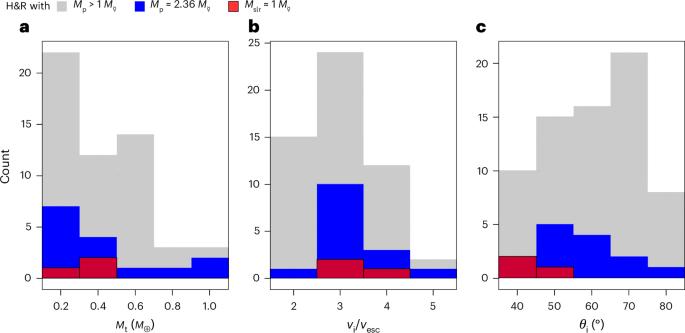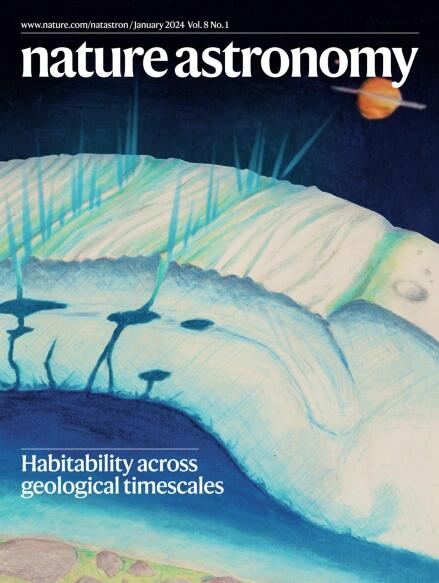水星的形成是由类似质量的天体碰撞形成的
IF 14.3
1区 物理与天体物理
Q1 ASTRONOMY & ASTROPHYSICS
引用次数: 0
摘要
与太阳系的其他岩石行星相比,水星的起源仍然知之甚少。为了解释它的内部结构,它通常被认为是一次巨大撞击的产物。然而,大多数研究都假设质量差异很大的物体之间存在二元碰撞,根据n体模拟,这似乎是不可能的。在这里,我们进行了光滑粒子流体动力学模拟,以研究在类似质量的物体碰撞能够形成类似水星的行星的条件。我们的研究结果表明,这种碰撞可以在小于5%的范围内满足质量(0.055 M⊕)和成分(硅酸盐与铁的质量比为30/70)的必要限制,只要根据良好的标度定律适当调整碰撞角度和速度。有了这些结果,我们通过提出那些在数值模拟中更频繁出现的、在行星环境中较少受限制的、因此更有可能发生的形成情景,扩大了合理形成情景的范围。本文章由计算机程序翻译,如有差异,请以英文原文为准。

Formation of Mercury by a grazing giant collision involving similar-mass bodies
The origin of Mercury still remains poorly understood compared with the other rocky planets of the Solar System. To explain its internal structure, it is usually considered to be the product of a giant impact. However, most studies assume a binary collision between bodies of substantially different masses, which seems to be unlikely according to N-body simulations. Here, we perform smoothed-particle hydrodynamics simulations to investigate the conditions under which collisions of similar-mass bodies are able to form a Mercury-like planet. Our results show that such collisions can fulfil the necessary constraints in terms of mass (0.055 M⊕) and composition (30/70 silicate-to-iron mass ratio) within less than 5%, as long as the impact angles and velocities are properly adjusted according to well established scaling laws. With these results, we broaden the scope of plausible formation scenarios by presenting those that are more frequent in numerical simulations, less constrained in planetary contexts and thus more likely to happen. A model with a more plausible collision scenario explains the formation of Mercury through a giant impact between two bodies of similar size. The model also obtains very accurate results in terms of the iron core-mass fraction.
求助全文
通过发布文献求助,成功后即可免费获取论文全文。
去求助
来源期刊

Nature Astronomy
Physics and Astronomy-Astronomy and Astrophysics
CiteScore
19.50
自引率
2.80%
发文量
252
期刊介绍:
Nature Astronomy, the oldest science, has played a significant role in the history of Nature. Throughout the years, pioneering discoveries such as the first quasar, exoplanet, and understanding of spiral nebulae have been reported in the journal. With the introduction of Nature Astronomy, the field now receives expanded coverage, welcoming research in astronomy, astrophysics, and planetary science. The primary objective is to encourage closer collaboration among researchers in these related areas.
Similar to other journals under the Nature brand, Nature Astronomy boasts a devoted team of professional editors, ensuring fairness and rigorous peer-review processes. The journal maintains high standards in copy-editing and production, ensuring timely publication and editorial independence.
In addition to original research, Nature Astronomy publishes a wide range of content, including Comments, Reviews, News and Views, Features, and Correspondence. This diverse collection covers various disciplines within astronomy and includes contributions from a diverse range of voices.
 求助内容:
求助内容: 应助结果提醒方式:
应助结果提醒方式:


